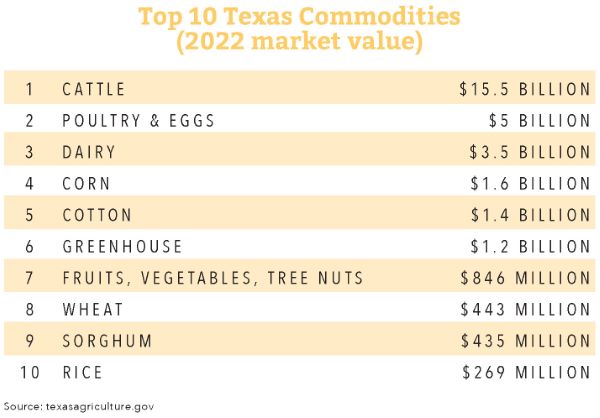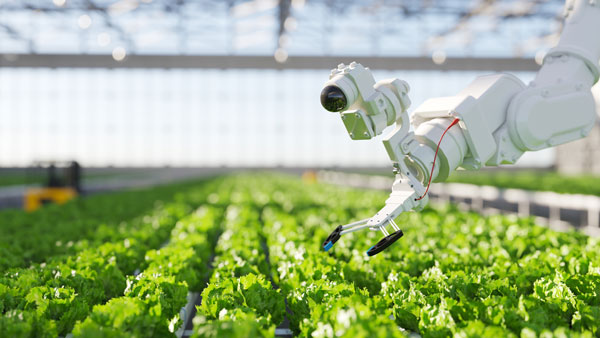Texas has millions of reasons to make meat lovers happy. According to the National Cattlemen’s Beef Association, 4.69 million beef cows graze the Texas plains. That’s tops in the nation, more than twice as many as second-ranked Oklahoma, and nearly 14% of the U.S. total. The King Ranch between Brownsville and Corpus Christi, the country’s biggest cattle ranch, spans 825,000 acres —an area larger than Rhode Island — and boasts a cattle population of 35,000.
All that beef is opening opportunities for processors, and Producer Owned Beef — owned by cattle producers and operated by processing industry veterans — is seizing on the potential. Aided by support from both the state and Amarillo Economic Development Corp (AEDC), the nascent enterprise is building a $670 million processing facility in the Texas Panhandle. Upon expected completion in 2026, it is to employ nearly 1,600 workers and process at least 3,000 cattle a day. According to an economic impact report by the Perryman Group, the plant is to generate $1.27 billion in gross product each year and 12,863 jobs in the Amarillo/Panhandle area.
For reasons such as those, AEDC and the state agreed to make significant investments in the project. AEDC granted the company more than 600 acres for the facility and incentives totaling $11.1 million. The Texas Enterprise Fund offered a grant of $12.2 million.
“The importance of Texas Enterprise Fund along with Amarillo EDC backing for this project cannot be overstated” said Casey Cameron, CEO of Producer Owned Beef.
Further bolstering the Panhandle’s status as the heart of cattle raising country, Tyson Foods recently expanded its Amarillo beef processing plant to the tune of $200 million. The company says the investment will allow it to expand and upgrade operations and build a new well-being area for team members. Kevin Carter, AEDC’s executive director, said the expansion “solidifies Tyson’s position as a top economic driver in our community for years to come.”

Bringing Ag Indoors
An expanding crop of indoor farms across Texas offers a vivid illustration of how agriculture is advancing beyond the time-honored practice of planting, praying for favorable weather and harvesting out in the scorching heat. Florida-based PLANT-AS, a hydroponic produce provider that’s making massive investments in West Texas, describes its indoor grow operations as “modern data centers.” They’re supported by artificial intelligence. Data collected and processed via IBM’s blockchain-supported system, says a release, “is the foundation of a digital infrastructure model that will transform the global food supply chain.”
 This is the new face of agriculture.
This is the new face of agriculture.
Photo: Getty Images/piranka
PLANT-AS is investing $1.1 billion to develop over 1,100 acres of Controlled Environment Agriculture (CEA) in Amarillo and Lubbock. At full buildout, expected to unfold over a decade, the two indoor farms are to employ about 1,600 workers with a combined payroll of $80 million. The company says it uses 70% to 90% less water than traditional agriculture methods.
“The end-to-end impact PLANT-AS will have on existing food systems begins with the agricultural process and extends all the way through the consumer experience,” said Plant-AS Director of Global Brand Representation Sara Gaul. “We are thrilled to be a part of the economic growth in West Texas. Together, we are building infrastructure for the future.”
New York-based Bright Farms is set to become the second-largest employer in the Texas town of Lorena, just south of Waco on Interstate 35. The indoor lettuce grower expects to create 255 jobs with a Phase-One investment of $120 million.
Ag-tech startup Eden Green Technology recently broke ground on a $40 million expansion of the indoor lettuce farm it launched south of Fort Worth in 2022. The expansion is projected to triple production to more than 5 million pounds of produce annually as the Texas-based company gears up for nationwide growth over the next five years.
And Local Bounti, based in Montana, is commencing operations at a $25 million indoor farm for growing leafy greens east of Dallas. The company expects to generate about 200 direct and indirect jobs throughout Titus County.
Fields of Plenty
In all, Texas leads the nation with nearly 250,000 farms and ranches covering more than 125 million acres. According to the Texas Department of Agriculture, 86% of the state is in some form of agricultural production. More than 95% of Texas farms and ranches are family-owned and operated, and one in seven working Texans is employed in something agriculture related. The economic impact of the Texas food and fiber sector ranges around $100 billion.

Photo: Getty Images
With its diverse climates and land, Texas supplies a wide variety of crops to markets in the United States and beyond. It’s the country’s top producer of watermelons and ranks second for carrots and pumpkins. The state is a major grower of citrus products, peppers, cabbages, cucumbers, mushrooms, pecans, peanuts and spinach.
And given all those cows, it should come as no surprise that Texas generally ranks among the top three states for milk and dairy production. In March, Walmart announced plans for a $350 million milk processing facility in the town of Robinson south of Waco. Slated to open in 2026, it is to bring 400 new jobs to McLellan County.
Products from the facility, Walmart says, will serve more than 750 Walmart stores and Sam’s Clubs throughout the South, including Texas, Oklahoma, Louisiana and parts of Arkansas and Mississippi.
“We’re excited,” said Bruce Heckman, vice president of Manufacturing at Walmart, “to be able to provide Texas and its surrounding states with high-quality milk sourced primarily from Texas dairy farmers.”

